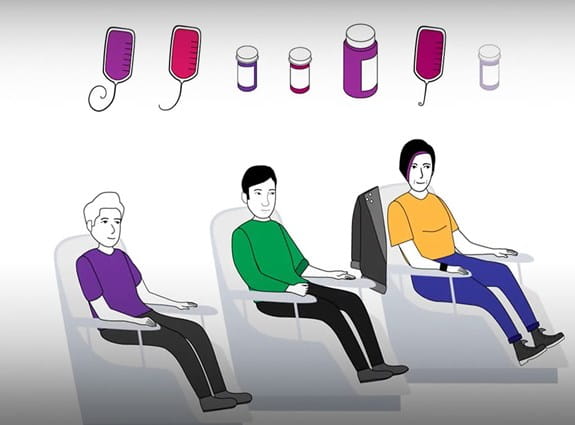How chemotherapy works
[The main character appears. She is a young woman with cancer. She is sitting in a chair, receiving chemotherapy through an IV in her arm.]
Narrator: Chemotherapy, sometimes called chemo, is a cancer treatment that uses drugs to target rapidly dividing cells throughout your whole body.
[Beside the main character, an outline of a human body appears. Coloured lines appear throughout the body to represent blood flow. The body outline changes into a pill bottle to represent oral chemotherapy drugs. Then the scene fades and yellow healthy cells, blue cancer cells and purple circles representing chemotherapy drugs fill the screen. As the chemotherapy drugs move across the screen, blue cancer cells and some yellow healthy cells disappear. The scene ends.]
Narrator: Chemotherapy can be given in different ways such as into a vein or by mouth. It kills cancer cells, but it also damages healthy cells.
[The main character sits in her treatment chair again along with 2 other people with cancer in treatment chairs. Above them, IV bags and pill bottles containing chemotherapy drugs appear. The 3 people in treatment chairs fade and are replaced by the main character sitting and talking with her oncologist in his office. Above them, the IV bags and pill bottles combine into groups to represent drug combinations.]
Narrator: Different chemotherapy drugs treat different cancers. Your healthcare team will create a treatment plan just for you, based on your health and the cancer. You may have more than one chemotherapy drug. This is called a combination.
[The main character and her oncologist fade and one of the drug combinations moves to the forefront on the left side of the screen. To its right, yellow healthy cells and blue cancer cells appear again. Purple and magenta circles representing the combination of 2 drugs move across the screen, making blue cancer cells and some yellow healthy cells disappear. The scene ends.]
Narrator: Combinations often work better than a single drug, but they also damage more cells and can cause more severe side effects.
[A hospital appears on the left and a house on the right. An arrow pointing from the hospital to the house represents having chemotherapy then going home for a rest period. Between the hospital and the house, a May calendar appears. Three days on the calendar are purple to represent treatment days, and 25 days are blue to represent rest days. The scene ends.]
Narrator: A course of chemotherapy is made up of several cycles. In each cycle, you have treatment and then a rest period. For example, a cycle may be 3 days of chemotherapy followed by 25 days of rest.
[The main character waters the flowers in her garden during the rest period. Some of the cells in her body appear in a bubble next to her. The yellow healthy cells become more vibrant, suggesting they are repairing themselves. The blue cancer cells disappear. The scene ends.]
Narrator: During the rest period, your healthy cells repair themselves and your body recovers. But cancer cells can’t repair themselves, so they die.
[Three people, including the main character, sit in chairs and are receiving chemotherapy. A May calendar appears above each person. The purple and blue days, representing treatment and rest days, are different on each calendar. This is because each person’s treatment plan is unique. On each calendar, a blood drop appears on the day before treatment starts, representing the day blood tests are done. The scene ends.]
Narrator: The number of cycles and the length of each cycle depend on your treatment plan. You’ll have blood tests before starting treatment to see what your normal blood counts are.
[A vial of blood appears in the middle of the screen. Beside it, a bubble with yellow healthy cells appears. Some of the cells disappear from the bubble to represent blood counts dropping. Then the cells that disappeared return, suggesting the blood counts are returning to normal. The bubble disappears and a lab technician appears beside the vial of blood. They sit at a desk and look at blood samples through a microscope.]
Narrator: Blood counts show the number of different blood cells. Chemotherapy kills blood cells, causing your blood counts to drop. But as you recover from treatment, they usually return to normal. Doctors will order blood tests throughout your treatment to see how chemotherapy is affecting your organs and how well your body is recovering.
[A May calendar appears on the left side of the screen. There are purple and blue days representing treatment and rest days. At the end of the rest period, there is a drop of blood representing blood tests. Hourglasses appear on the final days after the blood test, representing a delay in treatment, and a June calendar appears to the right of the May calendar. The first day of June has another hourglass, then a drop of blood representing more blood tests, then the treatment and rest cycle begins again.]
Narrator: The timing of your blood tests before each treatment is important to see if it’s safe for you to have chemotherapy. If your blood counts are too low or your organs aren’t working well, your team may delay chemotherapy or reduce the amount you are receiving.
[In the final scene of the video, the main character stands and talks with her doctor. A question mark appears above her head to suggest she is asking questions.]
Narrator: It’s important to go to your follow-up appointments during chemotherapy. Ask your doctor questions and tell them your concerns about treatment or side effects.
[The Canadian Cancer Society’s name, logo, phone number and website address appear in the centre of the screen. The Bank of Montreal (BMO) logo appears below as a proud sponsor of the Cancer Basics video series.]
Narrator: The Canadian Cancer Society is also here to help. Visit cancer.ca or call us at 1-888-939-3333.

